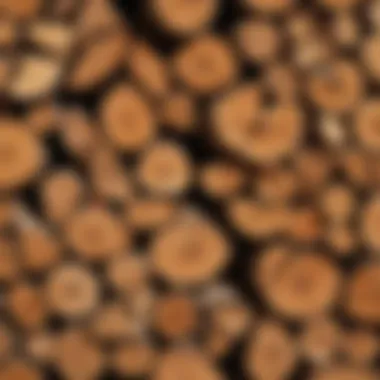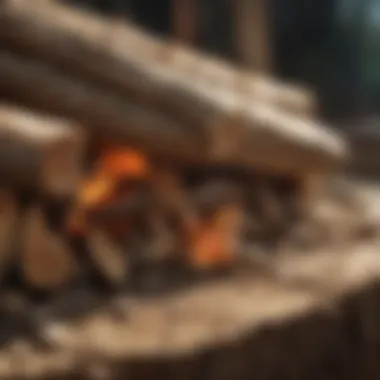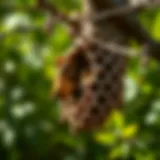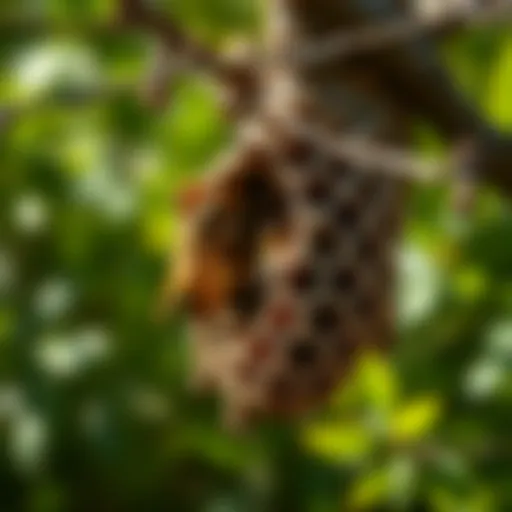Effective Strategies for Treating Firewood Against Termites


Intro
Treating firewood for termites is an essential aspect of home maintenance. Termites can cause significant damage to wooden structures and furnishings, leading to costly repairs. Understanding how to identify potential pest threats and implement effective treatments can safeguard your firewood and, by extension, your home. This guide outlines the biology of termites, prevention strategies, and practical treatment options to manage termites effectively.
Pest Identification
Identifying the presence of termites is crucial for early intervention. There are two primary species to be aware of when dealing with firewood: subterranean termites and drywood termites.
- Subterranean Termites: These pests live underground and build colonies that can extend over large areas. They require contact with soil to survive.
- Drywood Termites: Unlike subterranean species, drywood termites do not need soil moisture. They infest wood directly and can thrive in drier environments.
Signs and Symptoms of Infestations
Recognizing the signs of termite infestations can prevent severe damage. Look for:
- Mud Tubes: Small tunnels made of soil and wood fragments, often found on walls.
- Wood Damage: Hollow-sounding or crumbling wood indicates that termites are feeding inside.
- Frass: Termite droppings resemble tiny pellets or sawdust and are often found near infested wood.
"Acting quickly and decisively can save both time and money when dealing with termite threats."
Prevention Strategies
Once you understand pest identification, employ prevention strategies to safeguard your firewood.
Home Maintenance Tips for Pest Prevention
Basic maintenance of your home can significantly reduce the chances of termite infestation. Consider the following:
- Stack Firewood Off the Ground: Use pallets or platforms to prevent moisture from seeping into the wood.
- Seal Cracks and Gaps: Ensure that all potential entry points are sealed to reduce access for pests.
- Maintain Drainage: Proper drainage prevents water accumulation around the foundation, which can attract termites.
Natural Deterrents and Barriers
Certain natural substances can deter termites. Using these can supplement your prevention strategy:
- Essential Oils: Oils like lemon-scented eucalyptus or clove can be effective when applied to wood.
- Nematodes: Beneficial nematodes are microscopic worms that can be introduced into the soil to consume termites.
Treatment Options
When prevention fails or an infestation is confirmed, treatment becomes vital. Understanding the options available can help in making an informed decision.
Overview of Chemical vs. Natural Treatments
Both chemical and natural treatments exist for terminating termite threats. Chemical treatments often provide immediate results, while natural treatments are typically safer and environmentally friendly but may take longer. Evaluate the pros and cons of each before proceeding.
Step-by-Step Guides for DIY Treatments
If you're inclined to take a hands-on approach, here is a simplified method for both types of treatments:
Chemical Treatment
- Choose a Termiticide: Research and select a suitable product such as Fipronil or Imidacloprid.
- Apply the Treatment: Follow instructions carefully, ensuring thorough coverage on affected and surrounding areas.
- Monitor for Effectiveness: Regularly check for signs of termites after application.
Natural Treatment
- Prepare a Solution: Mix water with essential oils or vinegar.
- Apply Generously: Use a spray bottle to apply the solution to infested wood and surrounding areas.
- Reapply as Needed: Repeat treatments every few weeks to retain effectiveness.
In summary, understanding the biology of termites, incorporating preventive measures, and knowing your treatment options will empower homeowners to protect their firewood and homes efficiently.
Prelims to Termite Threats
By learning how to properly handle and treat firewood, homeowners can save themselves from expenses related to pest control and repairs. The importance of this knowledge cannot be overstated. Considering that termites are hidden and can thrive unnoticed, a reliable treatment must be an integral part of firewood management.
Understanding the Importance of Firewood Treatment
Firewood is often stored outdoors, making it an attractive target for termites, particularly in warm and humid environments. Proper treatment ensures that firewood remains a valuable resource rather than a breeding ground for pests. The benefits of treating firewood go beyond merely keeping it free of termites. It allows homeowners to use firewood efficiently while minimizing the risk of putting their homes at jeopardy at the same time.


Regular treatment of firewood reflects responsible management of residential spaces. It prevents the spread of termite infestation into the home and keeps firewood usable for heating and cooking purposes. Moreover, once the treatment is in place, there is peace of mind, knowing that the storage area is less likely to harbor these destructive pests.
Overview of Termite Behavior
Understanding termite behavior is crucial for effective treatment. Termites are social insects that thrive in colonies, primarily feeding on cellulose found in wood. They do not solely infest wood; they break down its structure, rendering it weak and unusable. Most notably, subterranean termites are often the culprits when it comes to infestations in firewood, as they typically reside underground and seek out wood by tunneling through the soil.
Termites operate in well-organized colonies, which means their activity can escalate quickly. Workers gather food, while soldiers protect the colony. Damage may go unnoticed until it is serious. By being proactive and understanding these behaviors, homeowners can treat firewood effectively and inhibit further infestations.
Important: Regularly monitoring both the firewood and its storage environment reduces the risk of termites and enhances treatment efficacy.
Identifying Termites in Firewood
Identifying termites effectively in firewood is crucial for any homeowner. Understanding the early signs of termite activity can save both your wood supply and your home from significant damage. Neglecting to recognize an infestation in its early stages can lead to costly repairs and potential structural hazards. Consequently, vigilance in inspecting firewood becomes an essential aspect of home maintenance.
Signs of Infestation
Several indicators can signal the presence of termites in firewood. Being aware of these signs allows one to act swiftly.
- Mud Tubes: Termites often build mud tubes to connect their nest to a food source. Look for these small tunnels; they typically appear on the surface of the wood or adjacent structures.
- Wood Damage: Inspect the firewood for hollowed areas or soft spots. Termites consume the wood from the inside out, leaving a shell that may look intact but is weak when touched.
- Frass: This is the term for termite droppings. It often resembles small pellets or sawdust. The presence of frass near firewood is a clear sign of an infestation.
- Sounds: When termites are active, they sometimes produce a faint sound as they chew wood. Listening closely can help identify their presence.
Identifying these signs early can prevent a small issue from becoming a major problem. Regularly checking the firewood before use helps in maintaining both the quality of the wood and a safe environment.
Common Types of Wood-Destroying Termites
Understanding which types of termites are likely to infest firewood is essential for effective management.
- Subterranean Termites: These termites live underground and often enter homes through the soil. They are the most common wood-destroying termites in many regions. Their colonies can be large, making them a significant threat to wood stored on or near the ground.
- Drywood Termites: Unlike subterranean termites, drywood termites reside in the wood they consume. They do not require contact with soil, making them a hidden threat. These termites can be found in the upper parts of buildings and may infest firewood kept indoors as well.
- Dampwood Termites: These termites primarily thrive in damp, decaying wood. If firewood is stored improperly or remains moist, it becomes susceptible to dampwood termites. They are less common but still a concern in wet environments.
Recognizing the specific type of termites that may be present can influence treatment strategies. Each type has varying behaviors and preferences, making targeted interventions more effective.
"Identifying termites early can lead to immediate measures that prevent serious damage to your home."
By remaining vigilant and understanding the signs of infestation, you can protect your firewood and home from these destructive pests.
Prevention Techniques for Firewood
Preventing termite infestations in firewood is essential for maintaining the integrity of your home and ensuring the longevity of your firewood supply. Understanding effective prevention techniques not only protects your investments but also reduces the risk of costly repairs due to termite damage. By taking proactive measures, homeowners can significantly decrease the likelihood of attracting termites, which are often drawn to wood that is improperly stored or untreated.
Selecting the Right Firewood
When it comes to firewood, not all types are equally vulnerable to termite infestations. It is crucial to select wood that is less appealing to termites. Dry and seasoned wood has a lower moisture content, making it less inviting for these pests. Additionally, hardwoods tend to resist termite damage better than softwoods. Some recommended wood types are oak, hickory, and cherry. These varieties not only provide better heat output but also have natural properties that deter termites.
Consideration should also be given to the source of the firewood. Avoid wood from areas with a known history of termite infestations. Inspecting firewood for any signs of damage before bringing it home can be beneficial. Look for tunnels or mud tubes, which are clear indicators of termite activity. Proper selection reduces the risk of introducing termites into your home environment.
Proper Storage Practices
Properly storing firewood is a critical step in preventing termite infestations. Firewood should be stacked off the ground, ideally on a concrete slab or a wood pallet. This elevation helps prevent moisture from the ground from seeping into the wood, which attracts termites. Allowing for airflow around the wood is also important. A well-ventilated area can help keep the wood dry and minimize the chances for pest attraction.
It is advisable to keep firewood away from your home. A distance of at least 20 feet is recommended to help prevent termites from easily invading your living space. Cover the wood with a tarp or a dedicated firewood cover only when it’s wet, as this helps keep it dry. However, ensure that the cover does not trap moisture underneath, as this could create a suitable environment for termites.
"Stack wood in neat rows to allow air circulation and prevent moisture accumulation."
In summary, prevention techniques focusing on selecting the right firewood and employing proper storage practices are foundational in safeguarding against termite infestations. By applying these methods, homeowners can significantly lower their risks, ensuring firewood remains a safe and reliable source of warmth.
Chemical Treatment Options
Chemical treatment for firewood is a crucial aspect of termite management. By employing various chemical methods, homeowners can significantly reduce the risk of termite infestations. These treatments serve as a barrier, often preventing termites from accessing firewood stored near homes. The effectiveness of chemical treatments can depend on several factors, including the treatment type, application method, and environmental conditions.
Utilizing chemical treatments not only protects precious firewood but also safeguards the entire home structure. When firewood is adequately treated, it becomes less attractive to termites, which tend to target untreated wood. This proactive approach minimizes the risk of large infestations that can lead to costly repairs and potential safety hazards.
Types of Chemical Treatments
There are several chemical treatments available, each with its own set of characteristics and benefits. Common types include:
- Insecticides: These are specifically designed to kill termites upon contact or ingestion. They often contain chemicals like fipronil and imidacloprid, which are effective in eliminating both drywood and subterranean termites.
- Boric acid: A natural compound that is effective for termite prevention. It works by dehydrating the termites and disrupting their digestive system when ingested. This method is less toxic for humans and pets, making it a preferred option for many homeowners.
- Preservatives: Chemicals like copper-based preservatives are useful in treating firewood before it is stored. They help prevent not only termite infestations but also decay and fungal growth.
- Foams and gels: These are applied into wood galleries and other hard-to-reach areas. They expand upon application to fill voids, ensuring better distribution of the chemical treatment.


Application Methods for Chemical Treatments
The application of chemical treatments requires careful consideration to ensure effective protection of firewood. Here are common methods of application:
- Direct spraying: Applying insecticides directly onto the surface of the firewood can provide immediate protection. Ensure that treatment penetrates the wood.
- Drenching: This method involves soaking the firewood in a chemical solution. It is particularly effective for larger pieces of wood where spray application may not suffice.
- Pressure treatment: This rigorous method infuses chemicals deep into the wood fibers. It is often used for large quantities of firewood and offers long-lasting protection.
- Injection: Using syringes or specialized tools, chemicals are injected directly into wood to target infested areas specifically. This precise method reduces chemical waste and minimizes exposure to non-infested areas.
Safety Precautions When Using Chemicals
When using chemical treatments for firewood, safety should always be a priority. Here are essential guidelines to consider:
- Read labels thoroughly: Before applying any chemical, read the label for instructions, precautions, and recommended application methods.
- Wear protective gear: Gloves, masks, and safety goggles should be worn to prevent chemical exposure to skin and respiratory systems.
- Ventilate the area: Ensure proper airflow around the application area. This helps minimize inhalation of chemical fumes.
- Keep away from children and pets: Store chemicals securely and maintain a safe distance during application to avoid any potential accidents.
"Proper chemical treatments can safeguard your firewood and home from termite threats, ensuring peace of mind in your firewood usage."
By understanding chemical treatment options, methods of application, and necessary safety precautions, homeowners can effectively manage termite risks in their stored firewood.
Natural Treatment Solutions
Natural treatment solutions for firewood are significant for maintaining the longevity of wood and preventing termite infestations. Many homeowners prefer these methods due to their environmentally friendly nature. Unlike chemical treatments, which can pose health risks and environmental concerns, natural remedies offer a practical and safe alternative.
Key Benefits of Natural Treatments:
- Safety: Natural substances often pose lower risks to human health and pets compared to synthetic chemicals.
- Effectiveness: Many natural remedies effectively deter termites through scents or natural toxins that are harmful to them.
- Eco-Friendly: These solutions are less likely to contaminate the environment or create unwanted chemical byproducts.
When addressing termite issues, understanding the various natural treatment solutions can aid in making informed choices. Not only do these methods provide protection against termites, but they also preserve the integrity of your valuable firewood.
Effective Natural Remedies
Some effective natural remedies for treating firewood against termites include:
- Essential Oils: Oils such as clove, neem, and orange are known for their repellent properties.
- Diatomaceous Earth: This powdery substance damages the exoskeletons of termites, effectively dehydrating and killing them when applied to infested wood.
- Vinegar: A common household item, vinegar can kill termites on contact. It’s a simple and effective solution that can be used for minor infestations.
Using these remedies not only targets existing pests but also helps to prevent future infestations. For instance, applying essential oils regularly can create an unfavorable environment for termites.
How to Apply Natural Treatments
The application of natural treatments is relatively straightforward. Here are general steps for using some of the most effective remedies:
- Essential Oils: Mix a few drops of clove oil or orange oil with a carrier oil and apply it directly to the wood using a brush or spray bottle. Repeat this every few weeks for ongoing protection.
- Diatomaceous Earth: Lightly dust the powder onto the surface of the firewood. Ensure you cover all sides to maximize effectiveness. Reapply after any rain or moisture.
- Vinegar: Mix equal parts of vinegar and water in a spray bottle. Spray the solution directly onto the affected areas of the wood. If needed, do this every few days until you see improvement.
"Natural treatments are often the first line of defense against pests due to their safety and effectiveness."
Ensure that you follow these applications precisely to maximize their benefits. Understanding each method’s effectiveness is crucial, as some may work better depending on the specific circumstances of the infestation. Employing these natural treatment methods can significantly reduce the threat posed by termites and ensure the usability of your firewood for heating, cooking, or other uses.
Long-Term Protection Strategies
Understanding the importance of long-term protection strategies is essential in the battle against termites. Proactive measures not only safeguard firewood but also contribute to a broader pest management ecosystem in your home. Employing long-term strategies minimizes the risk of infestations and ensures that your firewood remains a reliable resource for heating and cooking.
Effective long-term protection is about consistency and diligence. This focuses on maintaining a routine that includes regular inspections and careful integration of firewood into existing pest management plans. Each element is vital in protecting against future infestations, thus enhancing the longevity of your firewood supply.
Regular Inspections and Monitoring
Regular inspections serve as a cornerstone in termite prevention. It is not enough to treat firewood once; ongoing vigilance is necessary. By checking for signs of termite activity, such as small holes or frass (a sign of wood consumption), you can identify problems before they escalate. These inspections should ideally occur at least four times a year, though more frequent checks may be warranted during the warmer months when termites are most active.
To conduct an effective inspection, focus on the following areas:
- Visual Checks: Look for visible signs of infestation on your firewood, both stacked and stored. Check for soft or crumbling wood.
- Temperature and Moisture Levels: Termites thrive in warm and moist environments. Maintaining low moisture levels in stored wood can deter termite activity.
- Location and Access: Examine the area around your firewood for potential termite entry points. Keeping wood elevated off the ground helps promote airflow.
By establishing a routine for inspections and monitoring, you fundamentally change how you approach firewood management.
Integrating Firewood into Pest Management Plans
Integrating firewood into a broader pest management plan can yield significant benefits. This systemized approach is beneficial because it consolidates all pest control measures into a cohesive strategy. Firewood storage does not stand in isolation; it impacts and is impacted by your overall home environment.


When you integrate firewood management into pest control, consider the following:
- Coordinated Treatment Plans: Align firewood treatment with general pest control measures in your home. For instance, when pest control experts are treating other areas, ensure that your firewood gets examined and treated as well.
- Education and Training: Know the common pests that can affect firewood. Education on pest behavior supports more efficient management strategies.
- Regular Collaboration with Professionals: Consult pest control experts about specific needs pertaining to your firewood. Their insights can guide you in making informed decisions about treatment methods.
Integrating firewood into your pest management strategy not only preserves its quality and usability but also fortifies your home against possible infestations. Through these long-term strategies, the battle against termites can be effectively managed.
Myths and Misconceptions About Termites and Firewood
Understanding the myths surrounding termites and firewood is crucial in effective termite management. Many homeowners are misinformed about how termites behave and what can truly protect their firewood from infestation. These misconceptions can lead to ineffective treatment practices or unnecessary expenditures. Furthermore, incorrect beliefs can create unwarranted fear or complacency in handling firewood. Thus, debunking these myths helps in fostering a more informed approach, allowing homeowners to effectively safeguard their firewood and consequently their homes.
Common Myths Debunked
- Myth: Only Wet Wood Attracts Termites
It is a common belief that termites are only interested in damp wood. This is not entirely true. While moisture attracts termites, they can infest seasoned or dry wood as well. Termites have the ability to cause damage to any wood substance, regardless of moisture content. Therefore, dry firewood can still be a target if proper precautions are not taken. - Myth: Treatment is Only Necessary for Stored Firewood
Some homeowners think that only the firewood they store requires treatment, believing wood that is immediately used poses no threat. In reality, all firewood can harbor hidden termite infestations. Even wood that is used quickly can introduce termites into a living environment. Comprehensive treatment and preventive actions should be applied to all firewood, whether it is stored or not. - Myth: Termites Only Live in the Ground
A misconception exists that termites solely live in the ground, away from homes. Termites can also inhabit within structural wood, such as beams, flooring, or even furniture. Thus, a woodpile adjacent to the house can create a shortcut for termites to invade a home. - Myth: Borate Treatments are Only Effective When Wood is New
It is thought that borate treatments must be applied only to new firewood to effectively repel termites. However, the truth is that borate treatments can still be beneficial when applied to older wood, provided it is properly sealed. This treatment can help prevent current infestations and protect the wood’s integrity, regardless of its age.
"Knowing the truths about termites is as important as knowing how to treat your firewood efficiently."
- Myth: All Termite Treatments are Toxic
Many individuals avoid using treatments, fearing toxicity, assuming all available options pose health risks. In reality, there are natural treatments that can provide effective protection without harmful chemicals. Such remedies can be used with little risk to the family or pets. - Myth: If There are No Visible Signs, There is No Problem
Homeowners tend to think that if they do not see visible signs of termite damage, their firewood is safe. This is dangerous thinking. Many termites operate unseen within the wood, making early infestations especially difficult to detect. Regular inspections and proper treatment are necessary to ensure that your firewood remains protected.
By debunking these myths, homeowners can make better decisions regarding their firewood treatment strategies. Understanding what truly attracts termites and how to combat them efficiently will safeguard not just your firewood, but your entire home.
The Role of Professionals in Termite Management
Termites pose a significant threat to both structures and stored materials like firewood. Their ability to silently damage, often undetected, emphasizes the urgent need for effective management strategies. While homeowners can implement various preventive measures and treatments, the complex nature of termite biology and behavior often requires specialized knowledge and expertise. Engaging professionals in termite management offers multiple benefits.
One major advantage is the experience and skill professionals bring to the table. Pest control experts are trained to identify subtle signs of termite activity that might go unnoticed by the untrained eye. Their familiarity with local pest species enables them to devise tailored solutions specific to the kind of termites targeting your firewood. This precision increases the likelihood of successfully treating and preventing infestations.
Furthermore, professionals use advanced technology and methods unavailable to most homeowners. Treatments like thermal imaging and borate fumigation are among the tools they utilize to eradicate pests effectively. This level of sophistication can be critical, especially in cases of severe infestations where DIY methods may prove inadequate.
Additionally, the peace of mind that comes from hiring a professional cannot be overlooked. Termite control can be both time-consuming and stressful. By allowing professionals to take over, homeowners can focus on other essential responsibilities.
"Recognizing when to seek help from a pest control expert can save your home from extensive damage."
In summary, engaging professionals for termite management is not just a convenience; it’s often a necessity for effective and efficient treatment.
When to Call in Experts
Determining the right moment to contact a pest control professional can make all the difference. One clear sign is the discovery of live termites or visible damage to wood. If you notice:
- Hollowed wood or frass (termite droppings),
- Mud tubes leading to your firewood storage,
- Swarmed termites or discarded wings.
These are strong indicators that professional intervention is advisable. Another situation warrants immediate action if you have already implemented treatment measures, but signs of infestations persist or worsen. Professionals can assess the situation and suggest alternative or additional treatments.
Additionally, if your firewood storage is close to your home, any infestation can escalate quickly, affecting both your firewood and the structural integrity of your house. In these scenarios, it’s prudent to call in experts who can evaluate your risk levels and suggest comprehensive strategies.
Choosing a Pest Control Professional
Selecting the right pest control professional is crucial for effective termite management. Begin by researching local options; both online reviews and recommendations from neighbors or friends can provide insights into a pest control company's reputation. Ensure you look for:
- Licensing and Certification: Confirm that the company adheres to state regulations and holds required licenses.
- Experience: It's beneficial to choose a professional with a robust background in termite treatments specifically.
- Treatment Plans: Inquire if they offer both natural and chemical treatment methods so that you can make an informed choice fitting your preferences.
- Cost Estimates: Obtain detailed quotes, including what services are included. Low bids may indicate cut corners.
- Warranty: Warranty on services performed can provide assurance of quality and longevity.
In summary, selecting a pest control professional is a multifaceted decision. Understand your needs, ask informed questions, and prioritize companies that demonstrate expertise and reliability. With the right professional by your side, you can effectively safeguard your firewood and home from termite damage.
Culmination
The conclusion of the article reinforces the crucial topic of treating firewood for termites. This discussion crystallizes the importance of being proactive against potential infestations, as termites can cause significant damage to both the firewood and the home. Understanding prevention methods and treatment options is essential for homeowners and housewives alike.
Summary of Key Points
In summary, several key points highlight the relevance of this article:
- Termite Awareness: Recognizing the behavior and signs of termites is the first step in effective management.
- Prevention: Choosing the right firewood and storing it properly can significantly reduce the risk of infestation.
- Treatment Options: Both chemical and natural methods are available for treating firewood. Each has its unique application process and safety considerations.
- Long-Term Strategies: Regular inspections and incorporating firewood management into broader pest control plans are vital for long-term protection.
Final Thoughts on Firewood Treatment
Final thoughts emphasize that treating firewood goes beyond simple eradication methods. It is a continuous, multifaceted approach that involves education about termites and diligent application of treatment methods.
Establishing a routine not only enhances the longevity of your firewood but also safeguards your living space. Remember that effective termite management requires persistence and a commitment to ongoing monitoring. By applying the techniques discussed in this article, homeowners can ensure their firewood remains free from infestation and their homes safe from the destructive impact of termites.
"The best way to treat termites is to prevent them from needing treatment in the first place."
Overall, being informed and proactive about firewood treatment is fundamental for maintaining a safe and healthy environment.



